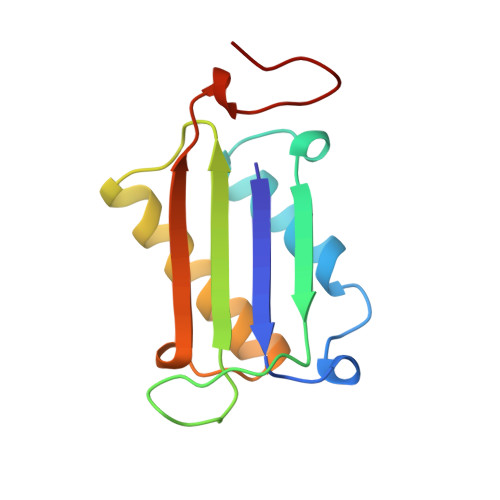Mechanism of the phenylpyruvate tautomerase activity of macrophage migration inhibitory factor: properties of the P1G, P1A, Y95F, and N97A mutants.
Stamps, S.L., Taylor, A.B., Wang, S.C., Hackert, M.L., Whitman, C.P.(2000) Biochemistry 39: 9671-9678
- PubMed: 10933783
- DOI: https://doi.org/10.1021/bi000373c
- Primary Citation of Related Structures:
1MFF - PubMed Abstract:
Phenylpyruvate tautomerase (PPT) has been studied periodically since its activity was first described over forty years ago. In the last two years, the mechanism of PPT has been investigated more extensively because of the discovery that PPT is the same protein as the immunoregulatory cytokine known as macrophage migration inhibitory factor (MIF). The mechanism of PPT is likely to involve general base-general acid catalysis. While several lines of evidence implicate Pro-1 as the general base, the identity of the general acid remains unknown. Crystal structures of MIF with the competitive inhibitor (E)-2-fluoro-p-hydroxycinnamate bound in the active site and that of the protein complexed with the enol form of a substrate, (p-hydroxyphenyl)pyruvate, suggest that Tyr-95 is the only candidate in the vicinity that can function as a general acid catalyst. Although Tyr-95 is nearby the bound inhibitor and substrate, it is not within hydrogen bonding distance of either ligand. In this study, Tyr-95 was mutated to phenylalanine, and the kinetic and structural properties of the Y95F mutant were determined. This alteration produces a fully active enzyme, which shows no significant structural changes in the active site. The results indicate that Tyr-95 does not function as the general acid catalyst in the reaction catalyzed by wild-type PPT. The mechanism of PPT was studied further by constructing and characterizing the kinetic properties of two mutants of Pro-1 (P1G and P1A) and one mutant of Asn-97 (N97A). The mutation of Asn-97, a residue implicated in the binding of the phenolic hydroxy group of the keto and enol isomers of (p-hydroxyphenyl)pyruvate and of (E)-2-fluoro-p-hydroxycinnamate affects only the binding affinity of the inhibitor. However, the mutations of Pro-1 have a profound effect on the values of k(cat) and k(cat)/K(m) and clearly show that Pro-1 is a critical residue in the reaction. The results are discussed in terms of a mechanism in which Pro-1 functions as both the general acid and the general base catalyst.
- Department of Chemistry and Biochemistry, and the Medicinal Chemistry Division, College of Pharmacy, The University of Texas, Austin, Texas 78712-1074, USA.
Organizational Affiliation:
















